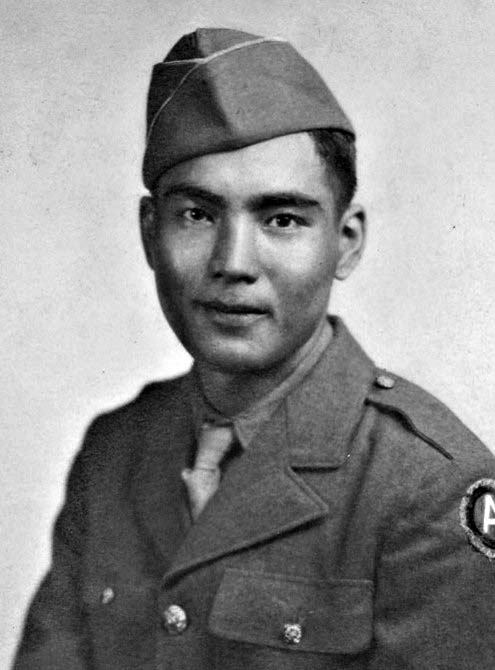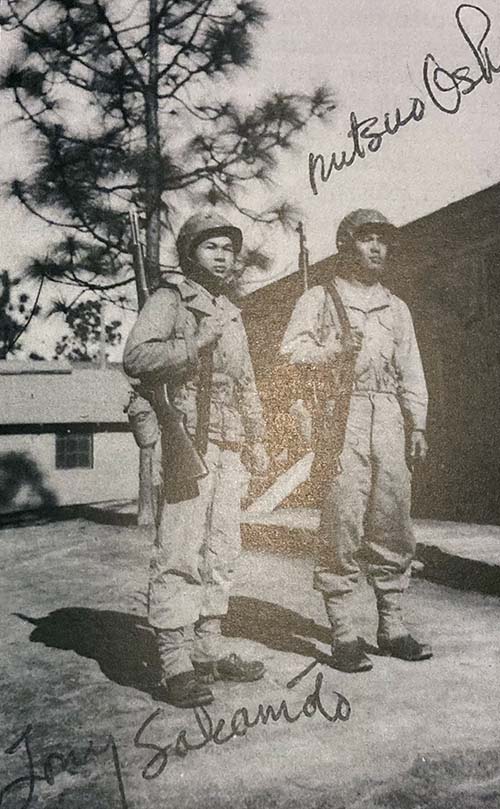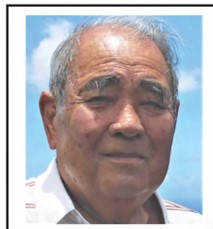
Mitsuo Oshiro
Private First Class
442nd Regimental Combat Team
3rd Battalion, I Company
Mitsuo Oshiro was born on September 20, 1922, in Waiau, Oahu, Territory of Hawaii. He was the third of six children: brothers Yoshio and Takeo, and sisters Shizue, Haru, and Sumiko. His parents, Taruro and Uto (Oshiro) Oshiro, emigrated from Tomigusuku Son, Okinawa Prefecture, Japan. Taruro’s last name was changed from Ogusuku to Oshiro during his emigration from Okinawa on October 28, 1912. Uto arrived in 1913. He worked at the Oahu Sugar Company in Ewa and Waipahu as a plantation laborer and Uto was a stay-at-home mother and housewife.

In 1930 and 1940, the family was living in Waipahu and Taruro was a truck driver for the sugar plantation company. Mitsu, as Mitsuo was known, graduated in 1936 from Waipahu Elementary School, and in 1940 from Farrington High School and Honpa Hongwanji Japanese Language School.
Senior class photo at Farrington High School
He then attended Honolulu Vocational School focusing on carpentry, and was hired as a second-class carpenter at the USED (U.S. Engineering Department) at nearby Hickam Air Field.
On December 7, 1941, while Mitsu was recovering from nasal surgery at Queens Hospital in Honolulu, he saw planes with distinctive red Japanese round markings flying above. He thought it was just some type of military maneuvers, but a hospital staff member shortly recommended that he return home to prepare beds for incoming military casualties. On his ride home, he passed Pearl Harbor, and saw the battleship USS Arizona burning. Hawaii was placed under martial law that same day.
In early 1942, Mitsu’s USED carpentry job was terminated, and he found work as a manual laborer digging 10’ x 10’ pits at the Makalapa Army camp where he and other Japanese Americans experienced racial discrimination.
At the age of 19, Mitsu registered for the draft on June 30, 1942, at Local Board No. 9 at August Ahrens School in Waipahu. His address was Camp 1 in Waipahu and his point of contact was his father. He was employed by Hawaiian Constructors at Hickam Field. At the time he was 5’5½” tall and weighed 125 pounds.
Mitsu was inducted into the U.S. Army on March 23, 1943, at Schofield Barracks. He had completed one year of college and was employed as a carpenter. After induction, he was among the volunteers housed at the “tent city” known as Boom Town. On March 28 they were given an aloha farewell ceremony at Iolani Palace. They departed on the SS Lurline on April 4 for Oakland, California, and a train trip across the US to Mississippi.

At Camp Shelby the new soldiers were assigned to their units prior to basic training. Mits, as he was also known, was in the Second Battalion, I Company. After a year of basic training followed by unit training and maneuvers, on April 22, 1944, they departed by train for Camp Patrick Henry, Virginia.
Tony Sakamoto and Mitsu Oshiro at Camp Shelby
The 442nd sailed from nearby Hampton Roads in a convoy of over 100 Tony Sakamoto and Mitsu Oshiro at Camp Shelby ships on May 2, and arrived at Naples, Italy, on May 30. They entered combat in the Rome-Arno Campaign on June 26, 1944.
For the next two months they pushed the Germans north along the Italian peninsula. On August 25, 1944, while the 442nd was engaged in patrol duty along the Arno River west of Florence, Oshiro later recalled being on his way to take a bath near a farmhouse. An enemy artillery shell hit and killed his squad’s radioman, Pfc. Gordon Shimizu, who was sitting quietly writing a letter. The burst also perforated Oshiro’s left eardrum. He turned to return to the house and another shell burst perforated his right eardrum and wounded the right side of his neck. He was taken to the aid station where he had difficulty swallowing seven large pills. He was taken to a hospital where he learned that his wound did not require surgery, and he soon returned to duty.
Following are some of Mitsu’s memories about his wartime experiences in Italy:
As each day passed while we were in combat, our equipment felt heavier and heavier. This was due to our daily food ration being 3 crackerjack boxes for the entire day’s meal. We were getting tired of eating the same thing for each meal. Breakfast consisted of 3 pieces of 1” x 2” x ¼”-thick concentrated crackers with little water. For lunch it was one small fruit bar and 3 pieces of crackers. Dinner was a half cup of water, powdered bouillon soup and a ham and egg mix. We would start a fire by burning the crackerjack box, then proceed to heat the soup. We would then eat the crackers with the soup. At times we would be provided “C rations” or hot food, now that used to be a treat!
When I was in active combat [I] did not shoot once. They taught us not to shoot until you see the enemy (German), because when you shoot the American gun, smoke comes out and it would show the enemy where you are. That’s why you don’t shoot. I did not see one enemy while in combat.
On another day, we were again entrenched on a flat plain. Again, we were bombarded by the Germans. I could hear the shrapnel flying (“zinging”) over our heads. I felt that the trench I was laying in was too shallow. About 5 or 6 o’clock, we started to march up the mountain. It took us till about 10-11 PM before finally reaching [the] top of it. We were given the order to fix bayonets and to engage the enemy without firing a shot. I had earlier thrown away my bayonet because of the weight I was carrying was getting heavier and heavier. Since I didn’t have the bayonet, I thought about what I had learned at basic training on hand-to-hand combat techniques which I would have to use if we engaged the enemy. We then marched down the mountain at 12 midnight. At the base of the mountain, we entered an eight-foot eroded ditch and followed each other in a single file. As it was getting lighter, we heard the firing of a machine gun in front of us. We were ordered to retreat at that time. We double-timed back because we thought that if a mortar shell hit the ditch we would be “goners.” We did not go all the way back to our point of entry of the ditch before we climbed out of it. As I was climbing out, I slipped back a little and the bayonet of the soldier who was climbing out behind hit my ‘okole’ which caused me to hasten my exit from the trench.
After going up and over a second hill, on my right a message was relayed to me which said “Four hundred yards, Gerries,” after which I relayed it to my left. At this time the men, who were fairly close to each other at the start of this charge, now were about 100 feet apart. The next message was “Three hundred yards, Gerries,” but I did not have time to relay this message because we were then being fired upon by the Germans. I ran about 25 yards and hit the ground in front of a 3-foot-high bush. After a while, I started to move a bit. I was at the edge of the bush and the Germans saw my movement and fired at me. I felt the dirt being disrupted next to me by the machine gun bullets, so I played “dead.” I was scared. After a while, I heard my BAR man calling me, but I did not respond. I did, however, without thinking, get up and run to my left up a small hill into a hole. I thought it was strange that I was not fired upon since the hill was in a wide-open area. I thought later that a prayer helped me get to the hole safely. I then decided to exit the hole and run down the reverse side of the hole. I felt some invisible force pull me back into the hole, so I stayed there. A mortar shell landed in the location where I would have been had I left the hole.
In another incident, we were located in a small town while our company was in reserve. I bought some eggplant in the morning and soaked it in salt water (tsukemono) in my helmet till dinnertime at which time we ate it. The next day we bought a rabbit and vegetables and cooked rabbit stew in my helmet (which we were not supposed to do) and had it for dinner. I had a “mean bellyache” from it.
While in the town we filled our canteens with water from a ditch. We placed one pill [in our canteens] to purify the water. It took about one hour before the water was drinkable. The next day we marched along the ditch and came across a dead horse and further upstream a dead pregnant Italian woman. Both of these were in the ditch with the water running through them. After seeing this it made me feel sick.
In late September 1944, as the 442nd was preparing for shipment to France for the Rhineland-Vosges Campaign, Oshiro again entered the hospital for nasal surgery relating to his earlier nasal surgery in 1941. After he was released from the hospital, he was assigned to carpentry work at a U.S. Army replacement depot in Italy, and later to the 41st Headquarters, Headquarters Squadron, with the Air Force stationed near Bari. He was there when the Germans in Italy surrendered on May 2, 1945.
His new unit was to be shipped to the Pacific Theater. Oshiro applied for a furlough to be returned to the US. This was granted and he was flown to Camp Beale, near Sacramento, California.
Pfc. Oshiro was discharged from the U.S. Army on November 19, 1945, at the Army Separation Center in Wahiawa.
For his military service, Private First Class Mitsuo Oshiro was awarded the following: Bronze Star Medal, Purple Heart Medal, Good Conduct Medal, Asiatic-Pacific Campaign Medal, European-African-Middle Eastern Campaign Medal with one bronze star, World War II Victory Medal, Army of Occupation Medal, and Combat Infantryman Badge. Oshiro was awarded the Congressional Gold Medal on October 5, 2010, along with the other veterans of the 100th/442nd Regimental Combat Team. This is the highest Congressional Civilian Medal.
After the war, Mitsu was hired as a machinist at the Pearl Harbor Naval Shipyard. His mother Uto died on November 4, 1948. The following year, Mitsu married Sumiko Nakamura on September 17, 1949, at the Waipahu Hongwanji Mission. They lived in Waipahu with his father. By 1950, Taruro was working in the tin repair shop at the sugar plantation. Mitsu and Sumiko raised a family of three children: Vernon, Deborah, and Brian.

Mitsu was an active member of the 442nd Veterans Club, Company I Chapter, and over the years he attended reunions in Las Vegas, Los Angeles, San Francisco, Honolulu, and Italy.
Mitsuo Oshiro passed away on October 10, 2021. He was survived by his wife, two children, and five grandchildren. Son Brian predeceased him. Mitsu was buried at Mililani Cemetery, north of Waipahu, with military honors and the 442nd Flag and I Company guidon present. He was remembered for his gentle kindness and generosity toward others and a deep spirituality that was rooted in love for his family and his fervent beliefs in the teachings of Shinnyo-En Buddhism.
Researched and written by the Sons & Daughters of the 442nd Regimental Combat Team, with assistance from his daughter, who is a member of the Sons & Daughters, in 2023.
